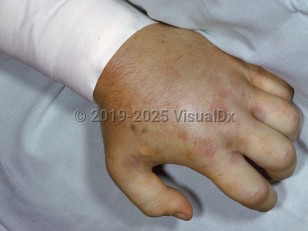Potentially life-threatening emergency
Pit viper snake envenomation in Adult
Alerts and Notices
Important News & Links
Synopsis

Pit vipers (family Viperidae; subfamily Crotalinae) include the rattlesnakes, cottonmouth water moccasins, and copperheads. They are native to the United States and are found in all states except Maine, Hawaii, and Alaska. Pit vipers have triangular heads, elliptical pupils, and heat-sensing pits below and anterior to their eyes. Two elongated, retractable, hollow fangs are located in their anterior upper jaws. When the snake bites, venom is conducted from the venom glands through ducts into the fangs. Rattlesnakes normally have rattles at the tip of their tail (except for one Mexican insular species).
Pit viper venom contains components that can affect multiple organ systems and can cause both local and systemic injury.
Pit viper bites most commonly occur in intoxicated young men who intentionally try to handle the snake, while other bites occur when victims inadvertently get too close to a snake. Care should be taken even when handling a dead or decapitated snake as the head may have an intact bite reflex. Bites from intentional interaction generally occur on the hands, whereas bites from unintentional encounters occur generally on the lower extremities.
Approximately 98% of all venomous snake bites in the United States are pit viper bites. Of those, 25% are mild and 20%-25% are "dry" bites (no envenomation). There are approximately 5 deaths annually in the United States from pit viper bites. The estimated mortality from a pit viper bite is approximately 0.1%. Presumably, this mortality is decreasing, as an increasing percentage of individuals bitten by pit vipers have been treated with antitoxin. After a pit viper bite, puncture wounds are usually seen. If envenomation has occurred, pain is generally felt immediately and soft tissue swelling soon follows. The swelling may spread rapidly and be significant. Ecchymoses, petechiae, clear vesicles, hemorrhagic bullae, regional lymphadenopathy, and tissue necrosis may develop, especially if antivenom is not administered.
Nausea and vomiting are common. Other systemic symptoms may include weakness, diaphoresis, chills, dizziness, a change in taste, hypersalivation, tingling or numbness (in the scalp, face, or digits), and muscle fasciculations. Blurred vision or frank blindness due to retinal hemorrhages may occur. With severe envenomation, consumptive coagulopathy, hypotension, pulmonary edema, renal failure, and hypovolemic shock (from bleeding and third spacing) may develop.
Some populations of the Mohave rattlesnake (Crotalus scutulatus) have venom that, unlike most pit viper venom, is largely neurotoxic. With envenomation by this snake, there may be a paucity of local findings but significant systemic neurotoxicity.
Pit viper venom contains components that can affect multiple organ systems and can cause both local and systemic injury.
Pit viper bites most commonly occur in intoxicated young men who intentionally try to handle the snake, while other bites occur when victims inadvertently get too close to a snake. Care should be taken even when handling a dead or decapitated snake as the head may have an intact bite reflex. Bites from intentional interaction generally occur on the hands, whereas bites from unintentional encounters occur generally on the lower extremities.
Approximately 98% of all venomous snake bites in the United States are pit viper bites. Of those, 25% are mild and 20%-25% are "dry" bites (no envenomation). There are approximately 5 deaths annually in the United States from pit viper bites. The estimated mortality from a pit viper bite is approximately 0.1%. Presumably, this mortality is decreasing, as an increasing percentage of individuals bitten by pit vipers have been treated with antitoxin. After a pit viper bite, puncture wounds are usually seen. If envenomation has occurred, pain is generally felt immediately and soft tissue swelling soon follows. The swelling may spread rapidly and be significant. Ecchymoses, petechiae, clear vesicles, hemorrhagic bullae, regional lymphadenopathy, and tissue necrosis may develop, especially if antivenom is not administered.
Nausea and vomiting are common. Other systemic symptoms may include weakness, diaphoresis, chills, dizziness, a change in taste, hypersalivation, tingling or numbness (in the scalp, face, or digits), and muscle fasciculations. Blurred vision or frank blindness due to retinal hemorrhages may occur. With severe envenomation, consumptive coagulopathy, hypotension, pulmonary edema, renal failure, and hypovolemic shock (from bleeding and third spacing) may develop.
Some populations of the Mohave rattlesnake (Crotalus scutulatus) have venom that, unlike most pit viper venom, is largely neurotoxic. With envenomation by this snake, there may be a paucity of local findings but significant systemic neurotoxicity.
Codes
ICD10CM:
T63.091A – Toxic effect of venom of other snake, accidental (unintentional), initial encounter
SNOMEDCT:
241807005 – Poisoning caused by pit viper venom
T63.091A – Toxic effect of venom of other snake, accidental (unintentional), initial encounter
SNOMEDCT:
241807005 – Poisoning caused by pit viper venom
Look For
Subscription Required
Diagnostic Pearls
Subscription Required
Differential Diagnosis & Pitfalls

To perform a comparison, select diagnoses from the classic differential
Subscription Required
Best Tests
Subscription Required
Management Pearls
Subscription Required
Therapy
Subscription Required
References
Subscription Required
Last Reviewed:03/28/2019
Last Updated:05/19/2019
Last Updated:05/19/2019
Potentially life-threatening emergency
 Patient Information for Pit viper snake envenomation in Adult
Patient Information for Pit viper snake envenomation in Adult
Premium Feature
VisualDx Patient Handouts
Available in the Elite package
- Improve treatment compliance
- Reduce after-hours questions
- Increase patient engagement and satisfaction
- Written in clear, easy-to-understand language. No confusing jargon.
- Available in English and Spanish
- Print out or email directly to your patient
Upgrade Today

Potentially life-threatening emergency
Pit viper snake envenomation in Adult

